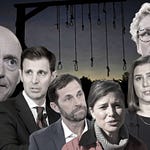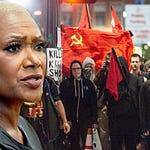The People’s Republic of China (PRC), under the iron grip of the Chinese Communist Party (CCP), has pursued a foreign policy that reeks of conquest and coercion, targeting nations like Australia, Japan, and Taiwan with calculated aggression. This approach, cloaked in diplomatic platitudes, seeks to bend sovereign states to Beijing’s will through economic leverage, military intimidation, and cultural infiltration.
The world must recognize the PRC’s actions for what they are—a bid for global dominance—and unite, particularly with the United States, to economically cripple China’s ability to threaten international peace and cultural integrity.
Segment 2: America’s Third Watch Segment
Segment 3: The Epidemic of Violence As Conflict Resolution In The US Black Community
A recent flashpoint in China’s belligerent posture is its reaction to Australia’s move to repatriate the strategically vital Darwin Port, leased to the Chinese-owned Landbridge Group in 2015. On April 7, 2025, Beijing issued a thinly veiled warning through Foreign Ministry spokesperson Lin Jian:
"We urge the Australian side to provide a fair, non-discriminatory and predictable business environment for Chinese enterprises investing and operating in Australia, and refrain from overstretching the concept of national security or politicising normal business cooperation."
This statement is a masterclass in hypocrisy. The CCP frames Australia’s defense of its sovereignty as discriminatory, while ignoring its own track record of weaponizing trade and investment to punish nations that defy its agenda. Australia’s decision to reclaim the port stems from legitimate security concerns, given its proximity to key military bases and its role in Indo-Pacific trade routes. Beijing’s protest reveals its intent to maintain strategic footholds abroad, treating foreign assets as pawns in its geopolitical chess game.
China’s playbook in Australia extends beyond Darwin. Since 2017, when Australia began scrutinizing Chinese influence in its politics and universities, Beijing retaliated with crippling trade sanctions, costing Australian exporters an estimated AU$20 billion. These measures targeted beef, barley, wine, and coal—sectors chosen to maximize economic pain and send a message: compliance with CCP interests is non-negotiable. The sanctions followed Australia’s call for an independent inquiry into COVID-19’s origins, exposing China’s sensitivity to scrutiny and its willingness to economically bludgeon smaller nations into submission. This isn’t diplomacy; it’s economic warfare aimed at eroding Australia’s autonomy.
Japan faces a similar onslaught. China’s aggressive posturing in the East China Sea, particularly around the Senkaku Islands, combines military provocations with economic pressure. The CCP’s coast guard and naval vessels routinely encroach on Japanese waters, testing Tokyo’s resolve while Beijing ramps up rhetoric claiming the islands as its own.
Japan, a key US ally, is targeted not just for its strategic location but for its role in the Quad—a security partnership with the U.S., Australia, and India that China views as a direct challenge. Beijing’s strategy is clear: intimidate Japan into distancing itself from Western alliances, thereby weakening the regional counterbalance to Chinese hegemony. Japan’s economic dependence on China, with $150 billion in annual trade, gives Beijing leverage to threaten tariffs or supply chain disruptions, as seen in 2010 when China restricted rare earth exports during a prior Senkaku dispute.
Taiwan, however, bears the brunt of China’s conquest-oriented ambitions. The CCP views Taiwan not as a sovereign democracy but as a renegade province to be reclaimed by force if necessary. Xi Jinping’s regime has escalated military incursions, with over 1,700 warplane sorties into Taiwan’s air defense zone in 2024 alone. These provocations, coupled with cyberattacks and disinformation campaigns, aim to destabilize Taiwan’s 23 million citizens and erode their will to resist.
Economically, China pressures global firms to shun Taiwan, punishing companies like TSMC if they align too closely with Western interests.
The CCP’s obsession with Taiwan isn’t just territorial—it’s cultural, seeking to erase a thriving democratic alternative to its authoritarian model. A Chinese takeover of Taiwan would not only disrupt global semiconductor supply chains but also signal to the world that resistance to Beijing is futile.
Lin Jian’s Darwin Port warning encapsulates China’s broader strategy: demand unfettered access to foreign markets while decrying any pushback as unfair. This tactic masks the CCP’s exploitation of open economies to advance its military and cultural ambitions. China’s Belt & Road Initiative, for instance, saddles nations with debt to secure strategic assets, as seen in Sri Lanka’s Hambantota Port.
Culturally, Confucius Institutes and media influence operations propagate CCP narratives, stifling criticism in host countries. In Australia, Chinese-language media outlets have been co-opted to echo Beijing’s line, while in Japan, CCP-linked donors have pressured universities to downplay human rights discussions.
The world cannot afford to appease this expansionist regime. Economic interdependence with China, once touted as a path to peace, has instead empowered the CCP to hold nations hostage. The United States, with its unmatched economic and military clout, must lead a global effort to dull China’s ability to project power. This means aggressive sanctions on Chinese firms tied to the People’s Liberation Army, tariffs to curb Beijing’s trade surpluses, and restrictions on technology transfers that fuel China’s war machine. The US has already added over 800 Chinese entities to its export control list since 2018, a move allies must emulate to starve China’s military-industrial complex.
Crippling China economically isn’t about containment—it’s about the survival of freedom. The CCP’s $18 trillion economy funds a military budget exceeding $225 billion, dwarfing regional rivals. China’s full complement of military personnel numbers over 2 million (the US complement stands at 1.3 million). Its navy, now the world’s largest by ship count, projects power from the South China Sea to the Indian Ocean.
Culturally, Beijing’s soft power campaigns aim to normalize authoritarianism, undermining democratic values worldwide. By reducing China’s economic capacity, the free world can limit its ability to coerce neighbors and export its dystopian vision.
Allies like Australia, Japan, and Taiwan are on the front lines, but they cannot counter China alone. Australia’s iron ore exports, Japan’s industrial supply chains, and Taiwan’s semiconductors are critical to the global economy, yet their reliance on Chinese markets creates vulnerabilities Beijing exploits. A united front, led by the US, must diversify trade, bolster regional alliances like AUKUS and the Quad, and invest in alternative supply chains. Europe, too, must shed its ambivalence, recognizing that China’s ambitions threaten the liberal order it cherishes.
The CCP’s response to Darwin’s repatriation is a microcosm of its global strategy: bully, deflect, and demand compliance. Lin Jian’s words are not a plea for fairness but a warning of retribution. The world must reject this coercion, aligning with the U.S. to economically weaken a regime that thrives on conquest. Only by curbing China’s financial lifeblood can we blunt its military saber-rattling and cultural overreach, preserving the sovereignty and values of nations like Australia, Japan, and Taiwan. The stakes are nothing less than the future of a free world.
Then, when we return, our segment on America’s Third Watch, broadcast nationally from our flagship station WGUL AM860 & FM93.7 in Tampa, Florida.
The Epidemic of Violence As Conflict
Resolution In The US Black Community
For over half a century, the Black community in the United States has been gripped by a devastating epidemic: violence as the default method for resolving conflicts. Since the 1970s, this reliance on physical confrontation—whether in street disputes or domestic clashes—has spiraled out of control, becoming a cultural reflex that threatens not only the community but American society at large.
The situation supercharged after Barack Obama’s presidency began in 2009, revealing a troubling paradox: even as a so-called Black man led the nation, the community’s descent into violence accelerated. The Black community’s persistent failure to confront this crisis head-on, coupled with its dismissal of accountability, signals a catastrophic trajectory. If left unaddressed, this epidemic risks unraveling social cohesion, deepening systemic divides, and perpetuating self-destruction.
The roots of this crisis trace back to the 1970s, when urban decay and economic decline hit Black communities hard. The FBI’s Uniform Crime Reporting (UCR) data from 1975 shows homicide rates in cities like Chicago and Detroit—home to large Black populations—soaring to 30 per 100,000 residents, triple the national average. By 1980, Black Americans, roughly 12% of the population, accounted for 48% of homicide victims, with 85% of these deaths intra-communal, per the Bureau of Justice Statistics (BJS).
The crack epidemic of the 1980s and gang proliferation in the 1990s only entrenched this pattern. Homicide became the leading cause of death for Black males aged 15–34, a grim statistic that persists today, according to the Centers for Disease Control and Prevention (CDC).
Yet, the election of Barack Obama in 2008, hailed as a transformative moment, marked an unexpected turning point—not for healing but for escalation. Between 2009 and 2016, violent crime in Black urban neighborhoods surged. A 2017 DOJ report noted a 23% increase in homicides in cities with significant Black populations during Obama’s tenure, compared to a 7% rise nationally. Chicago, Obama’s adopted hometown, saw murders climb from 459 in 2008 to 797 in 2016, with Black victims comprising 78% of the toll, per Chicago Police Department data. Nationwide, the CDC recorded a 31% spike in Black homicide rates from 2014 to 2016 alone, reaching 37 per 100,000 for Black males—eight times the national average. Firearms were involved in 91% of these cases.
This supercharging wasn’t just statistical—it was cultural. The Obama era, paradoxically, saw violence romanticized further. Social media platforms like YouTube and Vine (later Instagram) exploded with videos of Black youth brawls and shootings, racking up millions of views. A 2015 Journal of Urban Health study found 41% of Black teens in high-risk areas had engaged in physical fights to settle disputes, up from 33% in the early 2000s. Music glorifying “drills” and retribution dominated airwaves, with a 2018 American Journal of Public Health study linking such media to a 17% rise in aggressive behavior among Black youth. Yet, the community shrugged, treating these as mere entertainment rather than warning signs.
Why the escalation post-2008? Some cite systemic issues—poverty, segregation, joblessness—which persisted under Obama. A 2016 Pew Research study noted that 65% of Black families in the poorest urban areas remained stuck there since the 1970s, facing schools whose finances have been abused by city administrations and crumbling infrastructures ignored by the same. But this excuses too much. Other ethnic demographics endure hardship without comparable violence. The Black community’s refusal to foster nonviolent norms—through families, churches, or responsible community leadership—stands out. During Obama’s presidency, high-profile movements like Black Lives Matter focused on external actors (police and policy), sidestepping intra-communal carnage. Where were the marches against Black-on-Black violence? The silence was deafening.
The community’s inaction since the 1970s is infuriating. Community violence intervention (CVI) programs, like CeaseFire, cut shootings by up to 45% in pilot areas, per a 2024 Brady United report, but remain largely ignored. In the Obama years, ironically, federal grants for such initiatives flatlined, and community buy-in was tepid. A 2014 incident in St. Louis—where a CVI worker was attacked while de-escalating a dispute—barely registered outrage. Instead, leaders deflected, blaming systemic racism or guns, never the community’s own choices. This denialism, entrenched since the 1970s, hardened post-2008, as hope for change under Obama curdled into apathy.
If this epidemic—decades in the making and turbocharged since Obama—persists, society faces a bleak future. First, the Black community risks permanent marginalization. Violence repels investment, gutting neighborhoods. A 2023 CDC estimate pegs gun violence’s annual cost to Black communities at $45 billion—medical bills, lost wages, shattered lives. Schools decay, businesses flee, and poverty ossifies, locking generations into despair.
Second, the fallout endangers everyone. A 2024 DOJ report notes rising gun crimes in suburbs tied to urban spillover, eroding public safety. Police, overwhelmed, lean on heavy-handed tactics, fueling distrust. The Journal of Democracy warns that unchecked violence in divided societies undermines democratic norms, replacing dialogue with fear. If Black communities become chaos zones, stereotypes solidify, and social bonds fray.
Finally, the human toll is crushing. Black children grow up scarred—2023 data from Social Science & Medicine shows Black girls in violent areas with PTSD rates rivaling soldiers’. Normalizing violence since the 1970s has stolen hope, breeding fatalism. Post-Obama, this despair deepened as symbolic progress clashed with street-level reality.
The Black community must break this cycle, born in the 1970s and supercharged by the manufactured division and instilled entitlement of the Obama years. The Black community must take it upon itself to instill non-violent resolution in its community by emulating community violence intervention models and rejecting media that glorifies conflict. They—not everyone else, but they, themselves—must teach youth that strength lies in restraint, not tribal mentality violence. Other impoverished communities have pivoted away from violence throughout history, and it's well past time the Black community in the United States follows suit. It’s doable, but it demands honesty and commitment.
The Black community’s refusal to act isn’t just self-sabotage—it’s a betrayal of America’s future. Time’s running out.


















